Pinfish, Lagodon rhomboides
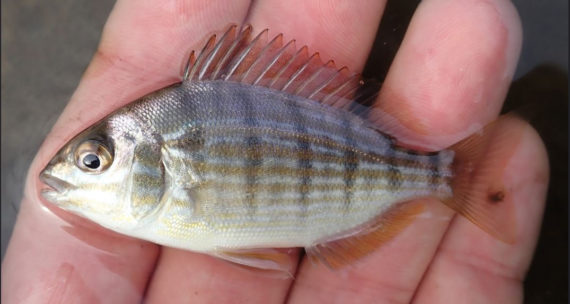 Pinfish, Lagodon rhomboids, Juvenile. Fish caught from coastal waters off Tampa, Florida, May 2018. Length: 7.4 cm (2.9 inches). Catch, photograph and identification courtesy of Ben Cantrell, San Diego, California.
Pinfish, Lagodon rhomboids, Juvenile. Fish caught from coastal waters off Tampa, Florida, May 2018. Length: 7.4 cm (2.9 inches). Catch, photograph and identification courtesy of Ben Cantrell, San Diego, California.
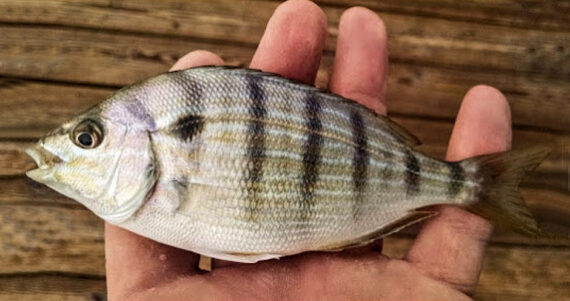 Pinfish, Lagodon rhomboids, Juvenile. Fish caught off the Lynnhaven Fishing Pier, Virginia Beach, Virginia, August 2015. Length: 12 cm (4.7 inches). Catch, photograph and identification courtesy of Marc Eberlein, Grand Rapids, Michigan.
Pinfish, Lagodon rhomboids, Juvenile. Fish caught off the Lynnhaven Fishing Pier, Virginia Beach, Virginia, August 2015. Length: 12 cm (4.7 inches). Catch, photograph and identification courtesy of Marc Eberlein, Grand Rapids, Michigan.
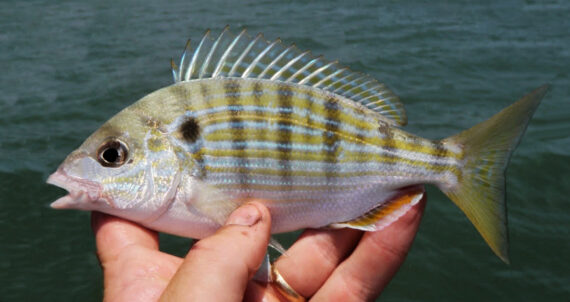 Pinfish, Lagodon rhomboids. Fish caught from coastal waters off Charleston, South Carolina, August 2018. Length: 15 cm (5.9 inches). Catch, photograph, and identification courtesy of Josh Leisen (joshadventures.com), Gaylord, Michigan.
Pinfish, Lagodon rhomboids. Fish caught from coastal waters off Charleston, South Carolina, August 2018. Length: 15 cm (5.9 inches). Catch, photograph, and identification courtesy of Josh Leisen (joshadventures.com), Gaylord, Michigan.
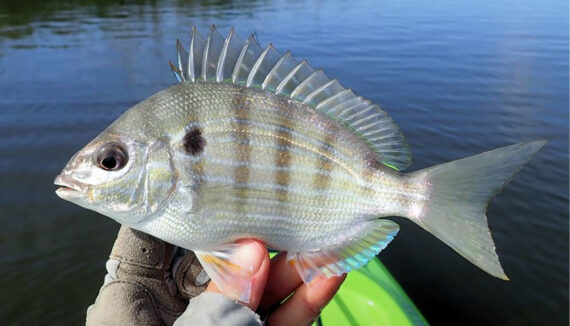 Pinfish, Lagodon rhomboids. Fish caught from within the Indian River Lagoon, Micco, Florida, November 2020. Length: 20 cm (7.9 inches). Catch, photograph and identification courtesy of Ben Cantrell, San Diego, California.
Pinfish, Lagodon rhomboids. Fish caught from within the Indian River Lagoon, Micco, Florida, November 2020. Length: 20 cm (7.9 inches). Catch, photograph and identification courtesy of Ben Cantrell, San Diego, California.
 Pinfish, Lagodon rhomboids. Fish caught from coastal waters off Mobile, Alabama, September 2023. Length: 20 cm (7.9 inches). Catch, photograph and identification courtesy of Luke Ovgard, Klamath Falls, Oregon.
Pinfish, Lagodon rhomboids. Fish caught from coastal waters off Mobile, Alabama, September 2023. Length: 20 cm (7.9 inches). Catch, photograph and identification courtesy of Luke Ovgard, Klamath Falls, Oregon.
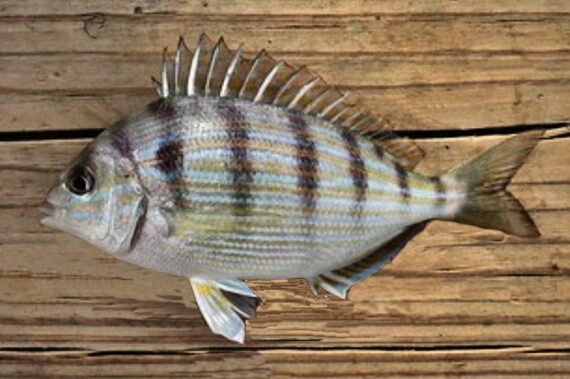 Pinfish, Lagodon rhomboids. Fish caught from coastal waters off Galveston, Texas, May 2013. Length: 20 cm (7.9 inches). Catch, photograph and identification courtesy of Eli (obsessiveangling.wordpress.com).
Pinfish, Lagodon rhomboids. Fish caught from coastal waters off Galveston, Texas, May 2013. Length: 20 cm (7.9 inches). Catch, photograph and identification courtesy of Eli (obsessiveangling.wordpress.com).
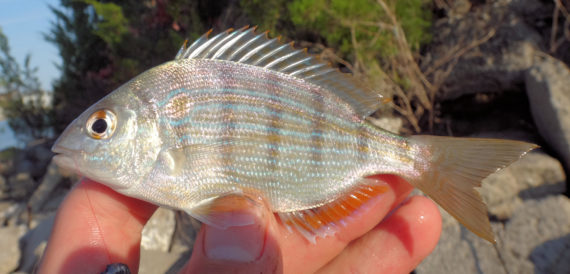 Pinfish, Lagodon rhomboids. Fish caught from coastal waters off Ocean Isle, North Carolina, December 2014. Length: 21 cm (8.3 inches). Catch, photograph and identification courtesy of Ben Cantrell, Peoria, Illinois.
Pinfish, Lagodon rhomboids. Fish caught from coastal waters off Ocean Isle, North Carolina, December 2014. Length: 21 cm (8.3 inches). Catch, photograph and identification courtesy of Ben Cantrell, Peoria, Illinois.
The Pinfish, Lagodon rhomboides, is a member of the Porgy or Sparidae Family, that is also known as “coffer” in Florida and as Mexicoas xlavita in Mexico. Their common name is derived from their single sharp rigid first dorsal spine that is capable of penetrating human skin. The Pinfish is the sole global member of the Lagodon Genus and is found in Mexican waters of the Atlantic Ocean.
The Pinfish has an oval compressed body with a depth that is 30% to 43% of standard length. They are bluish-silvery overall with alternating narrow blue and wide yellow longitudinal stripes and 6 dark diffuse vertical bars on their sides. They have a distinctive black spot near the origin of their lateral line behind the gill covers. Their fins are light yellow with broad light blue margins. They have a deep head with a pointed snout and a small terminal mouth that reaches the front margin of their eyes. They are equipped with 8 flattened broad incisors at the front of each jaw and 2 or 3 rows of molariform teeth on the sides of both jaws. Their anal fin has 3 spines and 11 rays; their caudal fin is forked; their dorsal fin has 13 spines and 12 rays; and their pectoral fins are longer than their pelvic fins. They are covered with small scales.
The Pinfish is a shallow water coastal species found in both estuarine and nearshore waters at depths between 9 m (30 feet) and 15 m (50 feet). Juveniles are found demersal in seagrass beds, rocky bottoms, jetties, pilings, and mangroves. They are found individually and in small groups. They reach a maximum of 40 cm (16 inches) in length 1.5 kg (3 lbs 5 oz) in weight. As of January 1, 2024, the International Game Fish Association world record stood at 1.5 kg (3 lbs 5 oz) with the fish caught in coastal waters off Horn Island, Mississippi in September 1992. They can tolerate water salinities from 0 to 75 grams per liter and temperatures between 10oC (50oF) and 35oC (95oF); they will die off in water temperatures below 4oC (40oF). Juveniles are carnivores and found primarily in estuaries; they consume amphipods, fish eggs, insect larvae, polychaete worms, and shrimp. Adults are herbivores and found in marine waters; they primarily consume plant materials. They are preyed upon by everything that swims including fish, marine mammals, and marine birds. Reproduction occurs in the fall and winter with large spawning aggregations of up to 1,000 individuals. Each female broadcasts up to 90,000 eggs several times a year which are then fertilized by males. Eggs hatch within 48 hours and larvae are pelagic being transported by currents to shallow water habitats, predominately seagrass meadows. They have a lifespan of up to seven years. The Pinfish is poorly studied with very limited information available about their lifestyle and behavioral patterns including specific details on age, growth, longevity, movement patterns, diet, habitat use, and reproduction.
The Pinfish is a resident of all waters of all Mexican waters of the Atlantic Ocean including the Gulf of Mexico and the Caribbean.
The Pinfish is most likely confused with the Sea Bream, Archosargus rhomboidalis (deeper oval body; narrow yellow lines; wide blue stripes).
From a conservation perspective the Pinfish is currently considered to be of Least Concern with stable, widely distributed populations. From a conservation perspective they are a vital component of coastal ecology as they help maintain the population numbers of certain crustaceans at reasonable levels and force new seagrass growth via foraging, which is essential to the long-term viability of these plants. The loss of seagrass habitat is considered highly detrimental to the long-term viability of this species. They are highly susceptible to pesticides and insecticides from runoff water and as such have been used extensively as test organisms in pesticide toxicity assays. A strong effort is currently ongoing to raise Pinfish in the Southeast United States via aquaculture as they have many attributes for farm rearing including rapid growth, ability to thrive in captivity, hardiness, tolerance to a wide range of environmental conditions. They are not considered to be an important sport or food fish due to their small stature and numerous bones however they are consumed by locals in certain parts of their range. The Pinfish, however is considered to be a premier live bait and used to target flounder, grouper, redfish, spotted sea trout, and tarpon. They are caught via cane poles with gold hooks tipped with shrimp, cast nets with chummed up fish, and specialized pinfish traps. They are considered a nuisance fish by recreational anglers as they are voracious bait stealers. They are also harvested commercially with beach seines, gill nets, traps and trawls and utilized to produce fishmeal and high grade fish oil.